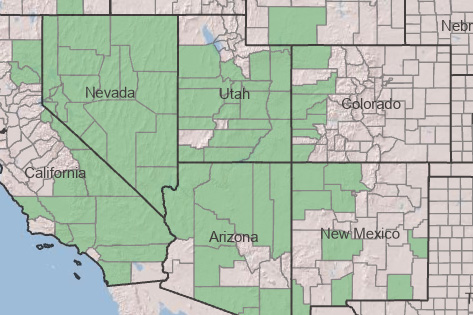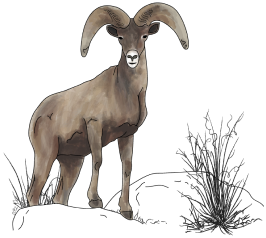Ephedra viridis Cov.
Viridiplantae > Streptophyta > Streptophytina > Embryophyta > Tracheophyta > Euphyllophyta > Spermatophyta > Acrogymnospermae > Gnetopsida > Gnetidae > Ephedrales > Ephedraceae > Ephedra > Ephedra viridis [1]
![Male flowers of Ephedra viridis [3].](/crfs/images/native-plants/plant-directory/greenephedra-first.jpg)
Male flowers of Ephedra viridis [3].
Shrubs 1-15 dm tall, spreading to erect. Branches rigid to flexible, bright green to yellow-green or less commonly olive to gray-green, initially opposite, in some finally falsely whorled, typically fastigiate and broomlike. Leaves opposite, 1.5-4 mm long, thickened dorsimedially, deciduous and leaving a thickened persistent brown base. Male cones 2 or more, obovoid, sessile, 5-7 mm long, the bracts opposite, 2-4 mm long, membranous, pale yellow, ovate. Female cones obovoid, 6-10 mm long, sessile or pedunculate, with 4-8 pairs of ovate bracts 4-7 mm long. Seeds paired, brown, triagonal, smooth, 5-8 mm long [2].
![Male flowering plant of Ephedra viridis [3].](/crfs/images/native-plants/plant-directory/greenephedra-sec.jpg)
Male flowering plant of Ephedra viridis [3].
Ephedra virdis, E. cutleri, and E. nevadensis have leaves and bracts in twos, whereas E. torreyana has leaves and bracts grouped in threes [3]. Ephedra cutleri has viscid, olive green stems and is typically only about two feet tall, but often ten to fifteen feet in diameter with many other dense colonies nearby. Ephedra viridis has smooth, yellow-green stems and is taller and often more solitary. Several floras consider E. cutleri to be E. viridis var. viscida [3]. Ephedra viridis can be distinguished from E. nevadensis by its brown, persistent leaf bases and fastigiate, yellow-green to green banchlets whereas E. nevadensis has gray, deciduous leaf bases and spreading, gray-green branchlet [2].
Ephedra viridis was first collected to science in 1893 during a collection expedition to Death Valley, California. It was determined to be distinct from E. nevadensis because of its bright green color compared to E. nevadensis' pale glaucous green color among other morphological differences. This bright green color is the source of E. viridis' specific epithet, which is latin for green and verdant [4].
![Fruits of Ephedra viridis [3].](/crfs/images/native-plants/plant-directory/greenephedra-third.jpg)
Fruits of Ephedra viridis [3].
Ephedra viridis is planted for landscaping in arid climates and is used in seed mixtures for revegetating depleted game ranges in the mountain shrub and juniper-pinyon types and optionally in the sagebrush type in Utah [6]. Early Mormon pioneers steeped the green or dry twigs in boiling water to make a tea for both social drink and more often as a medicinal, a use likely adopted from local Native American tribes [5]. Native Americans made a tea of stems and also a coffee-like tea from the roasted seeds, for both drink and medicinal purposes [7], to treat such ailments as coughs, colds, rheumatism, stomach ulcers, kidney problems, and anemia [8]. The Shoshoni, Havasupai, Paiute, and other tribes also used an infusion of the plant (minus the root) to treat various venereal diseases, including gonorrhea and syphilis, uses that likely contributed to another common name, whorehouse tea [9]. The Navajo of Arizona gathered the twigs and leaves and boiled them with alum to produce a light-tan color [10]. Navajos, Paiutes and other tribes have used the mature crushed stems for a yellowish green dye [11].
Asian species of Ephedra are known as the natural source of ephedrine and pseudoephedrine, alkaloids that are common in western cold and asthma pharmaceutical remedies, however, these are not found in considerable concentrations in any of the Utah Ephedra species [9, 12], but may still provide some relief via lesser quantities or similar compounds.

[7]
Green Ephedra (Ephedra viridis) has most recently been assessed for The IUCN Red List of Threatened Species in 2008. Ephedra viridis is listed as Least Concern [13].
This plant can be found in warm desert biomes, and is localized to blackbrush, salt desert shrub, sagebrush, pinyon-juniper, rabbitbrush, and mountain brush communities between 900 and 2950 m in its native range [2].
[1] “Taxonomy browser (Ephedra viridis).” NCBI, https://www.ncbi.nlm.nih.gov/Taxonomy/Browser/wwwtax.cgi?id=66172.
[2] Welsh, S. L. A Utah flora. 3rd ed., Brigham Young University Press, 2003. ISBN 0-8425-2556-4
[3] "Southwest Colorado Wildflowers, Ephedra." Southwest Colorado Wildflowers, www.swcoloradowildflowers.com/Yellow%20Enlarged%20Photo%20Pages/ephedra.htm
[4] Coville, Frederick V. 1893. “Botany of the Death Valley Expedition: Report on the Botany of the Expedition Sent Out in 1891 by the U. S. Department of Agriculture to Make a Biological Survey of the Region of Death Valley, California. Vol. 4. U.S. Government Printing Office.
[5] Bashore, M.L. 2016. Quitting Coffee and Tea: Marketing Alternatives Hot Drinks to Mormons. Journal of Mormon History, 42(1), pp.73-104.
[6] "NCRS Plant Guide: Green Ephedra, Ephedra viridis Cov." USDA Plants Database, plants.usda.gov/DocumentLibrary/plantguide/pdf/pg_epvi.pdf.
[7] USDA NRCS National Plant Data Team. "Ephedra viridis Coville Plant Profile." USDA Plants Database, plants.usda.gov/home/plantProfile?symbol=EPVI.
[8] Moerman, Daniel E. 1998. Native American Ethnobotany. Timber Press (OR).
[9] González-Juárez, D.E., Escobedo-Moratilla, A., Flores, J., Hidalgo-Figueroa, S., Martínez-Tagüeña, N., Morales-Jiménez, J., Muñiz-Ramírez, A., Pastor-Palacios, G., Pérez-Miranda, S., Ramírez-Hernández, A. and Trujillo, J., 2020. A review of the Ephedra genus: distribution, ecology, ethnobotany, phytochemistry and pharmacological properties. Molecules, 25(14), p.3283.
[10] Arizona State Museum, and Leland C. Wyman. 1951. The Ethnobotany of the Kayenta Navaho: An Analysis of the John and Louisa Wetherill Ethnobotanical Collection.
[11] "Green Ephedra." Native Memory Project, 17 June 2021, nativememoryproject.org/plant/green-ephedra/
[12] Caveney, S., Charlet, D.A., Freitag, H., Maier‐Stolte, M. and Starratt, A.N., 2001. New observations on the secondary chemistry of world Ephedra (Ephedraceae). American journal of botany, 88(7): 1199-1208.
[13] "Ephedra viridis Red List Assessment." IUCN Red List of Threatened Species, www.iucnredlist.org/species/201705/9169780.



